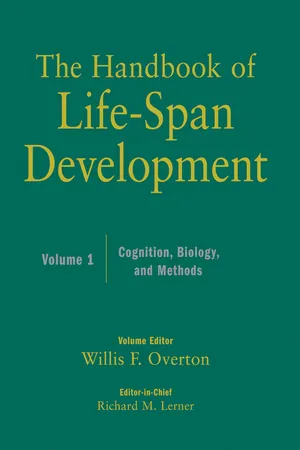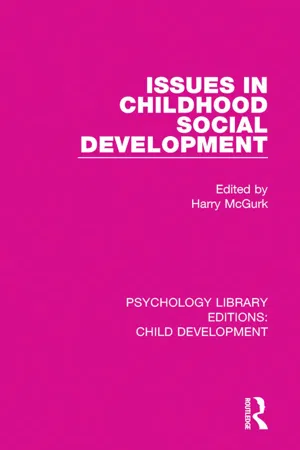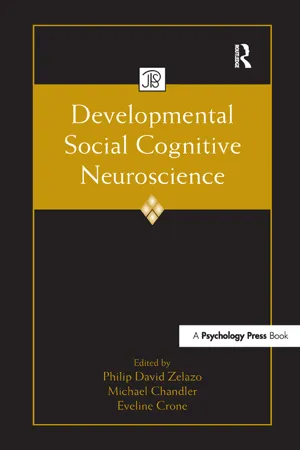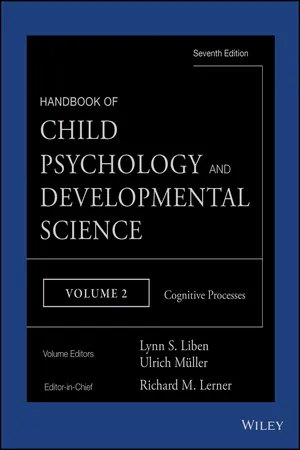Psychology
The Development of Social Cognition
The development of social cognition refers to the gradual acquisition of knowledge and understanding of social interactions, relationships, and norms. It encompasses the ability to perceive, interpret, and respond to social cues, emotions, and intentions. This developmental process is influenced by various factors such as cognitive maturation, social experiences, and cultural context.
Written by Perlego with AI-assistance
Related key terms
6 Key excerpts on "The Development of Social Cognition"
- eBook - ePub
The Handbook of Life-Span Development, Volume 1
Cognition, Biology, and Methods
- Richard M. Lerner, Willis F. Overton(Authors)
- 2010(Publication Date)
- Wiley(Publisher)
CHAPTER 17The Development of Social UnderstandingA Relational PerspectiveJEREMY I. M. CARPENDALE and CHARLIE LEWISSocial cognition refers to our understanding of social features of the world, of ourselves and others in psychological terms, as persons with beliefs, intentions, wishes, emotions, and desires. Other people are perhaps the most complex aspect of our worlds, and they are also the most interesting. They respond in lively and appropriate ways to the infant’s gestures, the child taking a toy, and the adult’s or older adult’s announcement of good or bad news. Social understanding is visible in everyday exchanges within interpersonal relationships. Examining such interpersonal activity in early development, we see the young child’s increasing grasp of the social world in these relationships. For this reason, the question of how we come to understand the mind and how this understanding changes across the life span has been of central interest to an interdisciplinary group of scholars, including developmental scientists, primatologists, philosophers, and social and cognitive scientists.This work was supported by the Social Sciences and Humanities Research Council of Canada and the Human Early Learning Partnership (to J.I.M.C.) and the Economic and Social Research Council (grant RES-576-25-0019, to C.L.).Within developmental science, this interest has been pursued in a number of different research literatures including “person perception,” “role taking,” and “metacognition” (Chandler, 1978; Chandler & Boyes, 1982; Flavell, 1992; Shantz, 1983). These terms all refer to thinking about social matters, although each derives from a different theoretical tradition. Metacognition, for example, refers to thinking about thinking and reflects an assumption that more complex thinking involves a hierarchy of nested relations between thoughts, thought about thoughts, thoughts about thoughts about thoughts, and so on, linked recursively together (see Mascolo & Fischer, Chapter 6 of this volume). This idea has been a driving force behind the cognitive revolution since the 1950s, and most developmental scientists are paid-up members of this movement. The term social cognition - eBook - ePub
- Harry McGurk(Author)
- 2017(Publication Date)
- Routledge(Publisher)
At first this seems like a bold stroke. The impact of outer forces is dampened by the child’s own cognition, thus passing some control of social development to the child himself. But on closer inspection, the introduction of cognition raises some serious questions. If cognition is defined literally as a process of self-construction with its own developmental course, then the risk is run that the environment of social agents can have minimal impact on social development. If, on the other hand, cognition is only one of several factors which intervene in development, its introduction is but a timid step. That is, cognitive theory becomes just another version of the old input-output model with its intervention merely adding complexity to the traditional formula.Our premise is that a different conceptualization is needed for the kind of cognition which services social development. An alternative approach is presented by way of a general framework. It is based on an interpretation of Piaget’s writings and is designed to clarify two conceptual issues: What is the nature of social knowledge? And, What is the process by which knowledge is socialized? The former question may be answered by Piaget’s treatment of knowledge as a relation. This suggests that interpersonal relations rather than the entities of ‘self’ and ‘other’ be made the basic unit of analysis. The second question may gain resolution when subject-subject interactions are made the intentional topic of social knowledge. This is to be distinguished from making knowledge a grasp of ‘other persons’ inner psychological workings’.Socialization and cognitionThe study of social development has always had two points of focus. On one side there is the child’s behaviour and on the second side there is the behaviour of other persons. The task of the social scientist is to explain the relation between them. In classical socialization theory the two sides of behaviour are said to come to a one-to-one correspondence. This is effected through the effort of other persons, called socializing agents, who influence and shape the child’s actions, thoughts and feelings. Correspondence can be achieved through direct means, such as imitation or reinforcement, or indirectly, as when parents act so as to create an internal state (e.g. ‘dependency’) which in turn controls the child’s output. - eBook - ePub
Forensic Psychiatry
Fundamentals and Clinical Practice
- Basant Puri, Ian H. Treasaden(Authors)
- 2017(Publication Date)
- CRC Press(Publisher)
8Developmental psychology
NATHALIA L. GJERSOE AND CATRIONA HAVARD Introduction Cognitive development Personality Social development Sexual development The child as witness Conclusion ReferencesINTRODUCTION
Developmental psychology is a discipline that encapsulates the full spectrum of psychological processes throughout the life span. Theories developed as part of this research have important implications not just for our understanding of children’s behavior and growth but also for how we conceptualize the human mind as a whole. Often there are processes so inextricably interwoven and sophisticated in adults that understanding them requires examination from their inception in the developing brain. This chapter focuses on the age range between infancy and late childhood and summarizes theories of children’s cognitive, personality, social, and sexual development, concluding with an outline of current opinion regarding children’s capacities as eyewitnesses.COGNITIVE DEVELOPMENT
Even newborns come into the world with a toolkit of basic sensory capacities and biases to attend to specific types of information. This stream of information forms the basis for mental representations—patterns of neuronal activity that refer to aspects of the external world. Developmental cognitive psychology examines mechanisms of change in mental representations throughout the life span. Examining cognitive development in infants and young children requires its own set of methodologies distinct from those used to examine adults. Children have limited communication and -comprehension abilities, disorganized or slow motor responses, and are easily distracted. Traditionally, research into cognitive development utilized naturalistic observation of children’s behavior at different ages and manipulated situations to determine if children’s responses changed in a reliable manner from age to age. This work has revealed a host of cognitive capabilities that all typically developing children seem to attain within a very similar time period—referred to as cognitive milestones - eBook - ePub
- Philip David Zelazo, Michael Chandler, Eveline Crone(Authors)
- 2016(Publication Date)
- Psychology Press(Publisher)
Our model of social cognitive development can also account for the abnormal development of social cognition in atypical cases. In this model, we view the ontogeny of The Development of Social Cognition in a “building block-like” manner. That is, each component of the system builds upon earlier developing components, assimilating later developing abilities into preexisting cognitive capacities. If an early component of the system, such as the ability to perceive biological motion cues, develops in an atypical fashion due to genetic factors or lack of adequate input, added levels may also not receive ample input due to decreased connectivity, or the input they receive may be impoverished or distorted. These later stages may be assimilated into an already compromised foundation, derailing the appropriate developmental trajectory for later the development of higher-order social cognition, such as the development of theory of mind. Future research will be needed to determine appropriate interventions to aid the atypically developing child in retaining not only appropriate social and cognitive behaviors, but adaptive brain functioning as well.Acknowledgments
The studies reviewed herein were supported in part by grants from the National Institute of Mental Health, the John Merck Scholars Fund, the National Institute of Child Health & Human Development, the Veterans Affairs Administration, Autism Speaks, & the National Institute for Neurological Disorders & Stroke. Kevin Pelphrey is supported by a Career Development Award from the National Institutes of health, NIMH Grant MH071284. We gratefully acknowledge our collaborators, especially Gregory McCarthy, James Morris, & Truett Allison.References
- Adolphs, R. (2001). The neurobiology of social cognition. Current Opinion in Neurobiology , 2(1), 231–239.
- Adolphs, R., Baron-Cohen, S., & Tranel, D. (2002). Impaired recognition of social emotions following amygdale damage. Journal of Cognitive Neuroscience , 14, 1264–1274.
- Allison, T., Puce, A., & McCarthy, G. (2000). Social perception from visual cues: Role of the STS region. Trends in Cognitive Sciences
- (Author)
- 2015(Publication Date)
- Wiley(Publisher)
An alternative position, also drawing on the theory metaphor, is that what enables children to pass the false belief test at about the age of 4 years is meta-representation, the ability to compare mental representations. This is the ability to consider both Maxi's perspective of where he left his chocolate as well as the knowledge of where the chocolate actually is (Perner, 1991). Although different from Wellman's position, Perner's is often identified within the same theory theory approach. Both assume that the child's understanding of the mind develops through a series of transitions, particularly at the age of 4 years, and both take an individualist stance.Another approach is that, rather than forming a theory, social understanding is based on imagining or simulating others' perspectives (e.g., Gordon, 1986; Harris, 1991, 2000; Johnson, 1988). From this perspective, development is explained through children getting better at simulating in order to understand others because they become more skilled at adjusting for the differences between what they know and desire compared to others.In opposition to the view that children formulate theories is the idea that they are essentially born with the ability to do such thinking in the form of an evolved innate module—the “Theory of Mind Mechanism” (Leslie, 1987). From this perspective, development occurs in general processing capacities, particularly the capacity to hold information in mind, which develops gradually in the preschool period (Fodor, 1992; Leslie, 2005). It has also been claimed that there are three modules in infancy prior to the “Theory of Mind Mechanism” that explain earlier social skills: the intentionality detector, the eye direction detector, and the shared attention mechanism (Baron-Cohen, 1995). One source of this idea was that older children with autism with a mental age of 4 were generally found to fail false belief tasks (Baron-Cohen, Leslie, & Frith, 1985), and this was interpreted as indicating that these children suffer from a specific deficit in social understanding. This tied in neatly with the second more general theoretical shift towards modular theories in areas as diverse as object recognition and pretence (Leslie, 1987).- eBook - ePub
Child Development
Concepts and Theories
- Jean A. Mercer(Author)
- 2018(Publication Date)
- SAGE Publications Ltd(Publisher)
Chapter 5 Concepts Related to the Development of Cognition and PerceptionChapter 5 is concerned with concepts that contribute to our understanding of children’s development of thinking, memory, and other cognitive processes. Theory plays an important role in the study of cognitive development, with valuable concepts having been contributed by the Swiss theorist Jean Piaget, by behaviourist thinkers, by dynamic systems theorists, and by others. Research methods specific to the study of cognitive development have been created. As these have shown, memory, thinking skills, communication, and language use all typically change developmentally from birth to age 12, following predictable developmental trajectories. Atypical cognitive development may interfere more or less severely with other aspects of children’s development.Introduction
The concept of cognition is a broad one that includes a range of mental and intellectual states and processes, including learning, memory, problem-solving, and symbol use. Cognition also includes the idea of concept use and formation that is the focus of this book. The extent of developmental change in cognition during childhood is evident when we think about the limited capacities of a 1-year-old and compare them to the much more advanced, almost adult-like, cognitive skills of a 12-year-old. Perception is a concept less frequently used in everyday thinking about child development; it may be thought of as involving processes that combine the sensory abilities discussed in Chapter 4 with cognitive advances, allowing the individual to make sense of the complex sensory world.Development story 5.1Five-year-old Oliver’s teacher, Ms McDonald, felt that he was ‘different’ soon after she met him. She noticed that he did not play much with other children at breaks, and did not even watch them as though he were interested but too shy to make friends. He seemed to be focused on his own concerns and would watch beetles or worms carefully. He did not seem unhappy and would answer briefly if asked a question. However, when frustrated Oliver would have a screaming tantrum, and Ms McDonald could usually not even understand what had frustrated him. Ms McDonald arranged a meeting with Oliver’s parents in the hope that she could find out more about him and understand what he needed before he got much older.
Learn about this page
Index pages curate the most relevant extracts from our library of academic textbooks. They’ve been created using an in-house natural language model (NLM), each adding context and meaning to key research topics.





